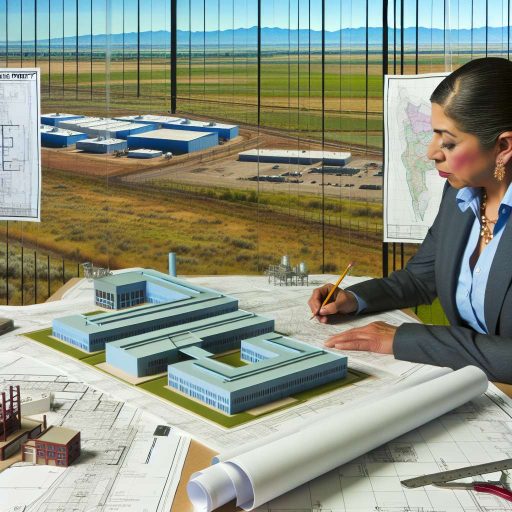Economic Factors
Impact of GDP Growth
GDP growth is a significant indicator of economic health.
A rising GDP generally signals increased demand for industrial properties.
This demand drives property values upward.
Consequently, areas with strong GDP growth tend to attract more investors.
Investors seek opportunities in thriving regions.
In addition, stable GDP growth encourages new businesses to enter the market.
These businesses require industrial space for operations.
Thus, a positive economic climate enhances industrial real estate values.
Influence of Unemployment Rates
Unemployment rates directly affect consumer spending and business activity.
Higher unemployment typically signals economic trouble.
This can lead to decreased demand for industrial space.
Inversely, lower unemployment rates usually result in increased hiring.
As businesses expand, they need more industrial facilities.
This situation creates a stronger demand for warehouses and manufacturing spaces.
Additionally, low unemployment can signal economic stability, attracting investors.
Transform Your Real Estate Decisions
Unlock personalized real estate insights crafted just for you. Get actionable advice designed to amplify your success.
Get StartedThe Relationship Between GDP and Unemployment
The relationship between GDP growth and unemployment is often inverse.
As GDP rises, unemployment tends to decrease.
This dynamic illustrates a healthy economic environment.
Such conditions are typically favorable for industrial real estate investment.
Therefore, understanding these metrics is vital for investors.
Monitoring GDP growth and unemployment can provide insight into real estate trends.
Ultimately, these economic indicators inform strategic investment decisions.
Location and Accessibility
Influence of Proximity to Major Highways
Accessibility plays a critical role in industrial real estate values.
Being near major highways boosts logistics efficiency significantly.
Companies can cut down transportation costs with accessible roadways.
Additionally, proximity to highways enhances delivery speed to clients.
This factor often attracts businesses seeking competitive advantages.
Impact of Nearby Ports
Ports are vital for industrial operations, especially for shipping goods.
Industries near ports enjoy expedited shipping and receiving capabilities.
Showcase Your Real Estate Business
Publish your company profile on our blog for just $200. Gain instant exposure and connect with a dedicated audience of real estate professionals and enthusiasts.
Publish Your ProfileThis proximity reduces the time it takes to move products internationally.
Moreover, businesses can avoid congestion delays through quick access.
Port proximity is attractive to companies involved in import and export.
Competitive Market Dynamics
Location influences the competition among industrial properties.
Regions near highways and ports can experience increased demand.
This demand can drive up property values significantly over time.
Conversely, remote locations may struggle with lower demand.
Businesses often prioritize accessibility when selecting new sites.
Long-term Planning Considerations
Strategically located properties tend to retain value better.
Long-term planning should consider future developments in transportation.
Infrastructure improvements can further enhance property values.
Investors need to evaluate location trends regularly.
Ultimately, location and accessibility remain key determinants of value.
Industrial Trends: Effects of E-commerce Growth on Warehouse and Distribution Centers
Impact of E-commerce on Demand
The rise of e-commerce significantly increases the demand for warehouse space.
Consumers expect faster delivery times, pushing companies to expand their distribution networks.
As a result, businesses seek strategically located warehouses closer to urban centers.
This trend affects industrial real estate values positively in high-demand areas.
Changes in Warehouse Design
E-commerce also influences warehouse design and functionality.
Modern warehouses require advanced technology for efficient operations.
Automated systems help optimize inventory management and order fulfillment processes.
Consequently, properties that integrate these features often command higher values.
Location Preferences
E-commerce firms prioritize locations with excellent transportation access.
Proximity to major highways and railroads becomes crucial.
Urban properties tend to see increased interest due to last-mile delivery needs.
This shift in location preference drives up prices in key metropolitan areas.
Investment Trends
Investors are targeting industrial real estate as e-commerce grows.
Real estate investment trusts (REITs) increasingly focus on logistics properties.
Enhanced competition for properties results in rising valuations overall.
Moreover, the belief in long-term growth in e-commerce bolsters investor confidence.
Environmental Considerations
Sustainability has become a priority for industrial properties.
Showcase Your Real Estate Business
Publish your company profile on our blog for just $200. Gain instant exposure and connect with a dedicated audience of real estate professionals and enthusiasts.
Publish Your ProfileGreen warehouses attract tenants looking for energy-efficient solutions.
Consequently, environmentally friendly features can elevate property values.
This trend aligns with both consumer preferences and corporate social responsibility goals.
The Evolution of Industrial Real Estate Amid E-commerce Growth
The growth of e-commerce profoundly shapes the industrial real estate landscape.
Trends in demand, design, location, investment, and sustainability influence property values.
As the market continues to evolve, these factors will remain critical to stakeholders.
You Might Also Like: Securing Long-Term Leases In Competitive Commercial Office Space Markets
Zoning Regulations: Understanding Local Government Policies and Restrictions
Overview of Zoning Regulations
Zoning regulations define how land can be used in specific areas.
They are crucial for urban planning and development.
Moreover, these regulations help maintain property values.
Local governments create zoning laws based on community needs.
Types of Zoning
Zoning can be categorized into several types.
Residential zoning regulates housing developments.
Commercial zoning supports businesses and services.
Industrial zoning is tailored for manufacturing and warehouses.
Additionally, mixed-use zoning combines various types within one area.
The Impact of Zoning on Property Values
Zoning directly affects property values in several ways.
First, it restricts the type of developments allowed.
This limitation can enhance property desirability.
Additionally, areas with stricter zoning often see higher values.
People prefer locations with clear development guidelines.
Navigating Local Zoning Boards
Understanding local zoning boards can be complex.
These boards grant permits and variances for developments.
They also enforce zoning regulations within their jurisdictions.
Therefore, engaging with these boards is essential for developers.
Active participation often yields better outcomes for projects.
Future Trends in Zoning Regulations
As cities evolve, zoning regulations must adapt.
Current trends lean towards sustainability and flexibility.
More communities are experimenting with zoning reforms.
These changes aim to accommodate modern living and working styles.
Showcase Your Real Estate Business
Publish your company profile on our blog for just $200. Gain instant exposure and connect with a dedicated audience of real estate professionals and enthusiasts.
Publish Your ProfileTherefore, staying informed about these trends is vital for investors.
Delve into the Subject: Optimizing Office Space Layouts For Productivity In Commercial Real Estate
Supply Chain Dynamics: The Role of Supply Chain Resilience on Property Demand
Understanding Supply Chain Resilience
Supply chain resilience is vital for economic stability.
It refers to a system’s ability to adapt and recover from disruptions.
Enhanced resilience leads to increased demand for industrial properties.
Impact of Disruptions on Industrial Real Estate
Disruptions significantly affect property values across the country.
Natural disasters, pandemics, and global conflicts shake market confidence.
These factors shift demand from vulnerable locations to more resilient areas.
Location and Infrastructure Influence
Strategically located industrial properties see heightened interest.
Infrastructure quality also plays a crucial role in property valuation.
Access to transport and logistics hubs boosts attractiveness for businesses.
Adaptation in Supply Chain Strategies
Companies are now reevaluating their supply chain strategies.
Diversification and localization become essential to minimize risks.
In turn, this encourages investment in local industrial real estate.
Technological Innovations Driving Change
Technology enhances supply chain efficiency and resilience.
Cloud computing and AI integrate seamlessly into property management.
As a result, companies are more inclined to invest in advanced facilities.
Economic Trends and Industrial Space Demand
The shifting economic landscape impacts real estate values.
Investors focus on industries that thrive amid uncertainty.
Logistics and e-commerce sectors fuel demand for distribution spaces.
Future Prospects for Industrial Real Estate
The future looks promising for resilient industrial properties.
Investors must stay informed about market dynamics and trends.
Ultimately, supply chain resilience will continue shaping property values.
Uncover the Details: Navigating Environmental Regulations In Industrial Property Ownership

Infrastructure Development: How Transportation and Utility Infrastructure Affects Value
Importance of Transportation Networks
Transportation networks significantly impact industrial real estate values.
Accessibility to major highways and railroads increases property demand.
For instance, facilities near interstate highways often attract more tenants.
This accessibility reduces shipping times and costs for businesses.
Additionally, proximity to airports enhances logistical efficiency.
Role of Utility Infrastructure
Utility infrastructure is crucial for industrial operations.
Showcase Your Real Estate Business
Publish your company profile on our blog for just $200. Gain instant exposure and connect with a dedicated audience of real estate professionals and enthusiasts.
Publish Your ProfileAccess to reliable water, electricity, and telecommunications is essential.
Properties with robust utility access often have higher appraised values.
Companies seek sites that can meet their operational needs quickly.
Impact of Local Government Policies
Local government policies can either enhance or detract from property values.
Incentives for infrastructure development can attract businesses.
For example, tax breaks for infrastructure investment encourage new projects.
Conversely, strict zoning laws may limit potential property use.
Interplay Between Infrastructure and Market Demand
The relationship between infrastructure and market demand is fundamental.
As urban areas expand, the demand for industrial spaces rises.
Developing infrastructure can support this growing demand effectively.
Consequently, cities investing in transport and utilities often see increased property values.
Case Studies and Examples
Several case studies illustrate these principles effectively.
The development of the Panama Canal significantly raised nearby property values.
Similarly, improvements in Chicago’s rail system boosted surrounding industrial land prices.
These examples highlight the value of strategic infrastructure investments.
See Related Content: Why Mixed-Use Developments Are the Future of Commercial Real Estate
Market Comparisons: Analyzing Regional Industrial Real Estate Price Trends
Understanding Regional Variations
Industrial real estate values vary significantly across the USA.
These variations reflect local economic conditions and demand for industrial space.
Understanding these regional differences is crucial for investors.
Trends in one region might differ greatly from another.
Key Economic Indicators
Economic indicators play a vital role in shaping real estate values.
Factors such as employment rates significantly impact demand for industrial space.
Additionally, local GDP growth rates provide insights into market strength.
Investors should monitor these indicators closely.
Demand and Supply Factors
Supply and demand dynamics greatly influence industrial property values.
Regions with high demand often see rising prices.
Conversely, areas with oversupply may experience declining values.
Analyzing local warehouse inventories can reveal insights about supply levels.
Infrastructure and Location Considerations
Infrastructure plays a critical role in industrial real estate pricing.
Regions with robust transportation networks tend to attract more demand.
Showcase Your Real Estate Business
Publish your company profile on our blog for just $200. Gain instant exposure and connect with a dedicated audience of real estate professionals and enthusiasts.
Publish Your ProfileProximity to major highways and ports enhances property value.
Location can significantly affect operational costs for businesses.
Influence of Federal and State Policies
Government policies directly impact industrial real estate markets.
Incentives for businesses can drive demand in specific regions.
Moreover, zoning laws affect the availability of industrial sites.
Investors should stay informed about legislative changes.
Case Studies of Varied Markets
Examining case studies provides practical insights into market behavior.
For example, the logistics market in Atlanta has flourished due to demand.
On the other hand, rustbelt regions have faced challenges recently.
Understanding these cases helps investors make informed decisions.
Current Trends and Future Projections
Current trends tell a compelling story about industrial real estate values.
As e-commerce continues to rise, demand for industrial space increases.
Future projections indicate significant growth potential in suburban areas.
Investors should remain adaptable to shifting market dynamics.
Technological Advancements
Impact of Automation on Industrial Real Estate Values
Automation significantly alters industrial real estate landscapes.
It enhances operational efficiency and drives down costs.
For example, robotic systems streamline warehousing processes.
As a result, businesses require smaller spaces yet higher technology standards.
This shift influences demand for specific property types.
Consequently, locations offering advanced infrastructural capabilities see increased interest.
Moreover, automated facilities generally have higher valuations.
Role of Green Technologies
Green technologies boost property values across the industrial sector.
These innovations promote sustainability and lower operating costs.
For instance, energy-efficient systems reduce utility expenses.
Moreover, environmentally friendly buildings attract eco-conscious tenants.
This trend elevates demand, leading to higher market prices.
Additionally, properties embracing sustainability gain regulatory advantages.
These benefits include tax incentives and grants for green initiatives.
Market Reactions to Technological Changes
Market responses to technological advancements can be immediate.
Investors closely monitor trends in automation and green technologies.
Showcase Your Real Estate Business
Publish your company profile on our blog for just $200. Gain instant exposure and connect with a dedicated audience of real estate professionals and enthusiasts.
Publish Your ProfileAs a result, they adjust their portfolios depending on technological demands.
Furthermore, real estate developers increasingly integrate new technologies.
This proactive approach helps maintain competitive advantages in the market.
Ultimately, technology fosters a dynamic environment for industrial real estate values.
Additional Resources
The donut effect: How COVID-19 shapes real estate | Stanford …
Commercial Real Estate in the US – Market Research Report (2014 …




